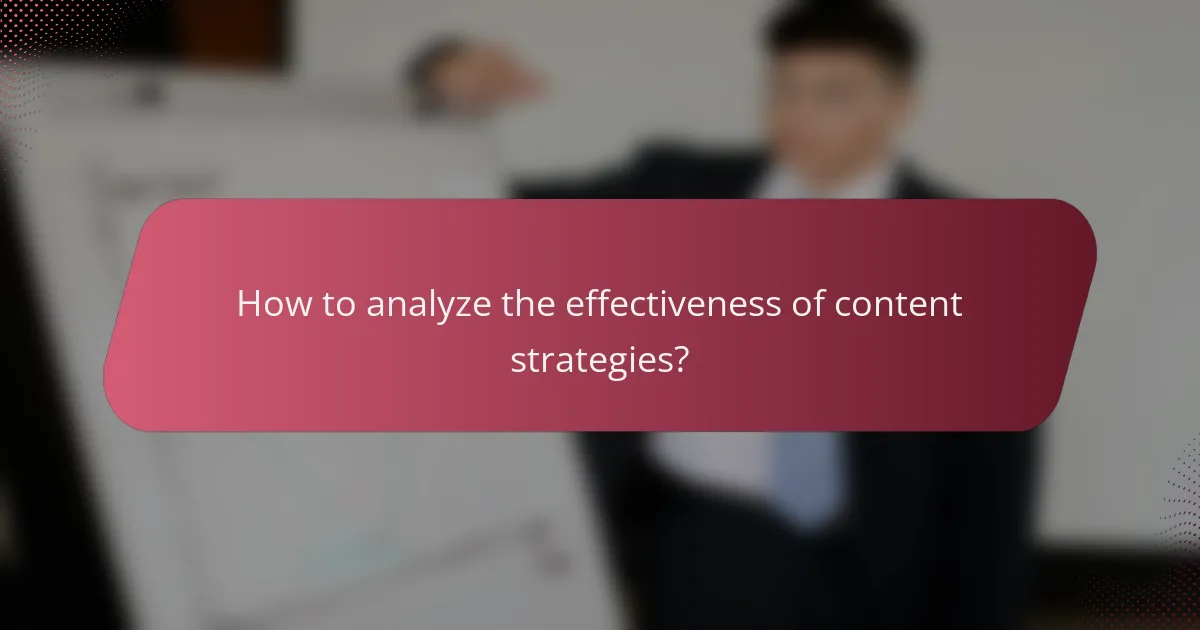Measuring textual content ROI is essential for understanding the financial returns generated from content investments relative to their costs. By employing techniques such as analytics tools, A/B testing, and engagement monitoring, businesses can assess key metrics like traffic growth and conversion rates to evaluate content effectiveness. This analysis not only highlights the impact of content on business objectives but also guides future content strategies for maximum returns.

How to measure textual content ROI effectively?
Measuring textual content ROI involves evaluating the financial return generated from content investments against the costs incurred. Key techniques include utilizing analytics tools, tracking conversions, analyzing customer feedback, conducting A/B testing, and monitoring engagement metrics.
Utilize web analytics tools
Web analytics tools like Google Analytics provide insights into how users interact with your content. By tracking metrics such as page views, time on page, and bounce rates, you can assess the effectiveness of your textual content in driving traffic and engagement.
Set up goals within these tools to measure specific actions, such as newsletter sign-ups or downloads, which can help quantify the ROI of your content efforts. Regularly review these analytics to identify trends and areas for improvement.
Implement conversion tracking
Conversion tracking allows you to measure how well your textual content drives desired actions, such as purchases or lead submissions. Use tracking codes or pixels to monitor user behavior after they engage with your content.
Consider setting up different conversion paths for various content types, such as blog posts versus landing pages, to understand which formats yield the highest returns. This data can inform future content strategies and investments.
Analyze customer feedback
Customer feedback provides qualitative insights into how your textual content resonates with your audience. Surveys, reviews, and social media comments can reveal what users find valuable or confusing about your content.
Regularly collect and analyze this feedback to identify strengths and weaknesses in your content strategy. Use insights to refine your messaging and improve overall effectiveness, ultimately enhancing ROI.
Conduct A/B testing
A/B testing involves comparing two versions of content to see which performs better in terms of user engagement and conversions. This method allows you to test different headlines, formats, or calls to action to determine what resonates most with your audience.
Run tests over a sufficient period to gather meaningful data, and ensure that you only change one variable at a time for accurate results. Use the insights gained to optimize your content for better ROI.
Monitor engagement metrics
Engagement metrics, such as social shares, comments, and click-through rates, provide valuable insights into how well your textual content captures audience interest. High engagement often correlates with better conversion rates and overall ROI.
Regularly track these metrics to gauge content performance and identify trends. Focus on creating content that encourages interaction, as this can lead to increased visibility and higher returns on your investment.

What key metrics indicate textual content ROI?
Key metrics that indicate textual content ROI include traffic growth, lead generation rates, conversion rates, customer retention, and social media shares. These metrics help assess the effectiveness of content in driving business objectives and maximizing returns.
Traffic growth
Traffic growth measures the increase in visitors to your website as a result of your textual content. A successful content strategy typically aims for a steady rise in unique visitors over time, often targeting growth rates of 10-30% annually.
To effectively track traffic growth, use tools like Google Analytics to monitor page views and user engagement. Look for spikes in traffic following content releases, which can indicate successful outreach or SEO performance.
Lead generation rates
Lead generation rates reflect the number of potential customers who express interest in your products or services after engaging with your content. A strong lead generation rate can range from 5-15% depending on the industry and content type.
To enhance lead generation, include clear calls-to-action (CTAs) within your content, such as downloadable resources or newsletter sign-ups. Regularly analyze which content types yield the highest lead rates to refine your strategy.
Conversion rates
Conversion rates indicate the percentage of visitors who take a desired action, such as making a purchase or filling out a form. A typical conversion rate for e-commerce sites may hover around 2-5%, while B2B sites might see lower rates due to longer sales cycles.
To improve conversion rates, ensure your content aligns with user intent and provides value. A/B testing different content formats and CTAs can help identify what resonates best with your audience.
Customer retention
Customer retention measures how well your content keeps existing customers engaged and returning for more. High retention rates, often above 70%, indicate that your content is successfully fostering loyalty and satisfaction.
To boost customer retention, focus on creating valuable, relevant content that addresses customer needs and interests. Regularly solicit feedback to ensure your content continues to meet their expectations.
Social media shares
Social media shares reflect how often your content is shared across various platforms, serving as a proxy for its reach and engagement. High share rates can indicate that your content resonates well with your audience, potentially leading to increased traffic and visibility.
To encourage social media shares, incorporate share buttons and create compelling, shareable content. Engaging visuals and strong headlines can significantly enhance shareability, driving organic growth through social networks.

How to analyze the effectiveness of content strategies?
To analyze the effectiveness of content strategies, focus on measurable outcomes such as engagement, conversion rates, and audience retention. These metrics provide insights into how well your content resonates with your target audience and its overall impact on business goals.
Perform content audits
Content audits involve systematically reviewing your existing content to evaluate its performance and relevance. This process helps identify high-performing pieces, gaps in topics, and areas needing improvement. Regular audits can reveal which content aligns with your current objectives and audience needs.
When conducting an audit, consider metrics like page views, time on page, and social shares. A simple checklist can include assessing content quality, SEO optimization, and alignment with brand messaging. Aim to perform audits at least once or twice a year to stay updated.
Benchmark against competitors
Benchmarking against competitors allows you to gauge your content’s performance relative to industry standards. Analyze competitors’ content strategies, engagement metrics, and audience interactions to identify best practices and potential areas for differentiation.
Use tools like SEMrush or Ahrefs to compare key metrics such as organic traffic, keyword rankings, and social media engagement. This analysis can help you set realistic goals and refine your content strategy to better compete in your market.
Assess user behavior
Assessing user behavior involves tracking how audiences interact with your content across various platforms. Understanding user journeys, click-through rates, and bounce rates can provide valuable insights into content effectiveness and areas for enhancement.
Utilize analytics tools like Google Analytics to monitor user engagement metrics. Look for patterns in how users navigate your site and which content keeps them engaged. Adjust your content strategy based on these insights to improve user experience and drive conversions.

What are the best practices for optimizing content ROI?
To optimize content ROI, focus on strategies that enhance audience engagement and improve conversion rates. Effective practices include targeting the right audience, enhancing content quality, utilizing SEO techniques, and leveraging marketing automation tools.
Focus on audience targeting
Identifying and understanding your target audience is crucial for maximizing content ROI. Tailor your content to meet the specific needs, preferences, and behaviors of your audience segments. Utilize analytics tools to gather insights about demographics, interests, and engagement patterns.
Consider creating buyer personas to represent your ideal customers. This helps in crafting content that resonates with them, ultimately driving higher engagement and conversion rates. Regularly revisit and update these personas based on new data to ensure relevance.
Enhance content quality
High-quality content is essential for retaining audience attention and driving conversions. Focus on creating informative, engaging, and well-structured content that provides real value to your readers. Use clear language, compelling visuals, and a consistent tone to enhance readability.
Incorporate storytelling techniques to make your content more relatable and memorable. Regularly review and update existing content to keep it fresh and relevant, ensuring it continues to meet the evolving needs of your audience.
Utilize SEO techniques
Implementing effective SEO techniques is vital for improving content visibility and attracting organic traffic. Start by conducting keyword research to identify relevant terms that your audience is searching for. Optimize your content by incorporating these keywords naturally into titles, headings, and body text.
Additionally, focus on on-page SEO elements such as meta descriptions, alt tags for images, and internal linking. Regularly monitor your search rankings and adjust your strategy based on performance metrics to ensure continuous improvement.
Leverage marketing automation
Marketing automation tools can significantly enhance your content ROI by streamlining processes and improving targeting. Use these tools to automate content distribution, track engagement, and analyze performance metrics. This allows for more efficient use of resources and better insights into what works.
Consider segmenting your audience for tailored messaging and using automated workflows to nurture leads through the sales funnel. This approach can help increase conversion rates and maximize the return on your content investment.

What frameworks can guide content ROI evaluation?
Content ROI evaluation can be guided by various frameworks that help organizations assess the effectiveness and profitability of their textual content. These frameworks typically focus on measuring both quantitative and qualitative outcomes, enabling a comprehensive understanding of content performance.
ROI calculation models
ROI calculation models provide structured approaches to quantify the return on investment from content initiatives. Common models include the simple ROI formula, which compares net profit to total costs, and more complex frameworks that factor in customer lifetime value and engagement metrics.
For example, a basic ROI calculation might look like this: if a content campaign costs $1,000 and generates $3,000 in revenue, the ROI would be 200%. However, it’s crucial to consider indirect benefits, such as brand awareness and customer loyalty, which may not be immediately quantifiable.
When selecting a model, consider the specific goals of your content strategy. If your focus is on lead generation, prioritize metrics like conversion rates and customer acquisition costs. For brand-building efforts, engagement metrics such as social shares and time spent on page may be more relevant.
